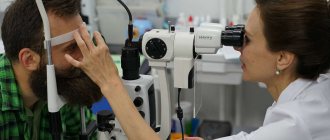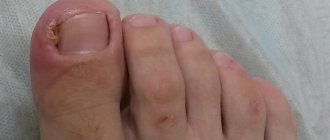Often in the morning a person does not look aesthetically pleasing enough; for example, the eyelids may swell. There is nothing terrible about this, but the appearance suffers considerably, especially if this happened to a representative of the fair sex. At the same time, men often experience discomfort when their eyes are swollen after sleep, since others may joke about the large amount of alcohol they drank or a stormy night. To know how to deal with this problem, you need to understand the main causes of this condition.
Why is this happening?
There are many reasons why your eyelids may swell in the morning. For example, the skin itself, which is located in this area, is very sensitive to external influences. If any circulatory problems occur in this area, the fluid very quickly stagnates in the skin tissue, which leads to the formation of so-called bags under the eyes. In addition, swelling in the eye area may be associated with insufficient fluid intake or with a large volume of water drunk directly at night.
Why do my eyes swell?
Physiological reasons
The most common physiological cause of puffiness under the eyes in the morning is the intake of large amounts of liquid, alcohol, spicy, salty foods in the evening. The swelling is bilateral, symmetrical. In the case of sleeping in one position, it may be stronger on the side on which the person slept. Disappears after 1-2 hours. Other triggering factors include:
- Overwork, lack of sleep, stress.
The body does not have time to recover overnight, and overload of the nervous system negatively affects the appearance. - Tears.
Crying in the evening causes swelling of the eyes the next morning, especially with intense rubbing of the skin and active use of a scarf. - Eye strain
. Occurs as a result of prolonged work on the computer, prolonged viewing of television programs. - Exposure to ultraviolet radiation
. The eyelids swell after exposure to the sun, which is associated with certain reactions in the skin and irritation of the mucous membrane.
Age plays a significant role in the appearance of edema. However, puffiness under the eyes in older people is not necessarily due to edema; a similar impression is created by fatty bags protruding under the skin. Unlike edema, this swelling is stable and does not decrease during the day.
Cosmetics, cosmetic procedures
In women, eye swelling sometimes occurs due to improper use of cosmetics (for example, applying a greasy cream at night), the use of products with skin irritating components, and individual intolerance. Another possible cosmetic reason is tattooing.
Normally, swelling after tattooing disappears within 24 hours. Long-term persistence of a symptom may indicate poor quality or too deep introduction of pigment, incorrect choice of anesthetic, increased dryness of the eyelid skin, or the development of an allergic reaction. In addition, short-term reactive edema is detected after anti-aging procedures: eyelid lifting, contouring.
Swelling of the upper eyelid
Hormonal fluctuations in women
Many women notice swelling in their eyes before their period begins. This symptom is especially pronounced in patients with premenstrual syndrome. Hormonal changes during gestation contribute to the accumulation of fluid in tissues, so pregnant women often notice swelling under the eyes, which increases as pregnancy progresses. Along with physiological hormonal changes, edema can be caused by impaired renal function.
Menopause is also associated with changes in hormone levels. During this period, patients are often bothered by pasty eyelids and faces, which are most noticeable in the morning and do not disappear even with sufficient sleep and strict adherence to the drinking regime. Sometimes swelling in the elderly develops as a result of hormone replacement therapy, and in women of reproductive age - as a result of taking oral contraceptives.
Eye diseases
Edema is accompanied by many inflammatory and non-inflammatory eye lesions. The following pathologies cause swelling:
- Conjunctivitis.
There are many types of conjunctivitis (viral, bacterial, fungal, non-infectious), which differ somewhat in their clinical manifestations. Common symptoms are swelling of the eyelids and conjunctiva, usually mild, hyperemia, a feeling of “sand,” itching, burning, and lacrimation. - Keratitis.
Damage to the cornea is caused by injuries, infections, diseases of other eye structures, allergies, and vitamin deficiency. Along with swelling, pain, intolerance to bright light, foreign body sensation, and blepharospasm are observed. - Tenonite.
Inflammation of Tenon's capsule, as a rule, has an infectious etiology. The swelling is accompanied by exophthalmos, double vision, intense pain radiating to the forehead and brow ridges. - Keratomalacia.
Focal necrosis of the cornea is often bilateral in nature and is provoked by protein starvation and liver disease. Swelling and hyperemia of the eyelids, lacrimation, photophobia, decreased vision, and the formation of corneal defects are observed. - Keratopathy.
Swelling of the eyes is detected in the neurotrophic form, combined with clouding and loss of sensitivity of the cornea.
Purulent processes
Styes are the most common reason for visiting ophthalmologists and are accompanied by limited local swelling. The swelling quickly grows, is accompanied by pain, hyperemia, and sometimes reaches such a degree that the patient cannot open his eyes. Then a yellowish purulent focus appears in the center of the swelling. After spontaneous or active opening of the abscess, swelling and other manifestations quickly regress.
With an uninfected chalazion there is no swelling. The development of the inflammatory process is marked by the appearance of local swelling, redness, and pain. When an abscess or phlegmon of the eyelid forms, the swelling becomes pronounced and spreads to the entire eye. There is throbbing pain, sometimes blepharitis, hyperthermia, and symptoms of intoxication are detected.
Dacryocystitis occurs against the background of dacryostenosis (impaired patency of the lacrimal canal). The swelling is localized in the inner corner of the eye. When pressing on the affected area, a purulent or mucopurulent secretion is released from the lacrimal openings. The pathology may be complicated by phlegmon of the lacrimal sac. In such cases, the eyelid closes completely due to swelling; the swelling covers the cheek, paranasal area, and sometimes the opposite side of the face.
With endophthalmitis, the swelling is moderate, there is a pronounced injection of the mucous membrane, and the formation of a purulent focus visible through the pupil. In patients with panophthalmitis, all structures of the eye are involved in the process. The swelling is so severe that it sometimes leads to pinching of the mucous membrane of the eyelids. Exophthalmos, clouding of the cornea, melting of the iris, and a sharp decrease in vision up to blindness are detected.
Erysipelas of the eyelids is manifested by pronounced swelling, spreading to the upper part of the cheek. Movement of the eyelids is limited due to swelling. The skin in the affected area becomes hot and painful. In the gangrenous form, the formation of ulcerative defects is observed. An increase in temperature, symptoms of intoxication, and regional lymphadenitis are noted.
Traumatic injuries
Swelling is a constant symptom of mechanical eye damage, which includes:
- Blunt injuries
: iris contusion, iridodialysis, subluxation and dislocation of the lens, hemophthalmos, scleral ruptures. The symptom is determined from the side of the lesion, combined with hematomas of the eyelids, hemorrhages into the structures of the eye. - Wounds
: damage to the structures of the eye by foreign bodies and foreign objects that do not remain in the wound. Initially, the swelling is minor, but progresses with infection and complications. - Orbital damage
: rupture of the superior oblique muscle tendon, fractures of the walls of the orbit. Rapidly increasing swelling is typical. Hematomas, subcutaneous emphysema, exophthalmos or endophthalmos are detected.
Eye burns are often chemical, caused by alkalis, acids, components of aerosol self-defense products, construction paints, and varnishes. Thermal damage develops under the influence of steam, metal particles, and flammable mixtures for fireworks. Radiation burns are caused by ionizing radiation, infrared or ultraviolet rays.
A special form of radiation burns to the eyes is snow blindness - damage to the eyes by ultraviolet radiation at high altitudes. Swelling from burns is combined with lacrimation, photophobia, pain, redness of the skin of the eyelids and conjunctiva. In severe cases, foci of necrosis form. When exposed to heat, the structures of the eye may remain intact due to the reflex closure of the palpebral fissure.
In addition, severe swelling and periorbital hematomas are observed with fractures of nearby bone structures: the upper jaw, zygomatic bone, and nasal bones. Particular attention should be paid to fractures of the base of the skull (middle cranial fossa), in which the symptom of glasses - hemorrhages, swelling of the periorbital zone does not appear immediately, but 12-24 hours after the injury.
Specific infections
Lesions with puffy eyes can be associated with infection with bacteria, viruses, and intracellular parasites that cause STIs. Infection with chlamydia trachomatis occurs by contact - the pathogen enters the eyes through hands, napkins, handkerchiefs, and towels. Causes trachoma, which initially occurs with symptoms of conjunctivitis (paratrachoma), and then is complicated by damage to the cornea.
Blenorrhea in adults in 2/3 of cases is provoked by gonococci, sometimes associations with chlamydia are detected. Swelling, redness, and suppuration from the eyes are noted. The formation of corneal ulcers, the development of endophthalmitis, panophthalmitis are possible. Ophthalmoherpes is caused by the herpes simplex virus and occurs due to accidental infection or persistence of the pathogen in the body. Edema is combined with manifestations of conjunctivitis, uveitis, and iridocyclitis.
Parasitoses
The list of parasitic infections with eye swelling includes the following diseases:
- Loiasis.
Burning, swelling of the eyelids, conjunctival hyperemia, lacrimation, sensation of parasite movement occur against the background of complete health, and disappear when the worm penetrates the periorbital tissue. - Dermatobiasis.
When a botfly larva gets into the eye, ophthalmomyasis develops, accompanied by swelling, pain, blurred vision, and a feeling of movement under the skin. - Dirofilariasis.
Small roundworms often penetrate the tissue of the eyelids and conjunctiva. The external manifestations of the disease resemble angioedema. Along with swelling, there is a decrease in the mobility of the eyelid, severe itching, and lacrimation. - Trichinosis.
Trichinella larvae spread throughout the body, so there are pronounced general symptoms: weakness, hyperthermia, muscle pain, digestive disorders.
Allergy
Sudden swelling, itching, burning, and redness of the conjunctiva are found in allergic conjunctivitis and blepharoconjunctivitis. During the flowering period of plants, hay fever conjunctivitis is often detected. At other times of the year, swelling of the eyelids and other symptoms can be explained by allergies to salicylates, house dust, and animal hair. Pronounced swelling of the eyes in combination with swelling of the face and difficulty breathing is observed with Quincke's edema.
Autoimmune pathologies
Orbital pseudotumor is most often diagnosed in patients suffering from autoimmune diseases: SLE, periarteritis nodosa, Wegener's disease. Depending on the location of the lesion (oculomotor muscles, lacrimal glands, blood vessels), swelling can be combined with diplopia, exophthalmos, pain, ptosis, hyperemia of the skin and mucous membranes.
Endocrine ophthalmopathy develops in patients with autoimmune pathologies of the thyroid gland. It manifests itself as swelling of the periorbital area, photophobia, lacrimation, a feeling of pressure, “sand” in the eyes. Unilateral or asymmetric exophthalmos may occur. The course of the pathology is chronic and progressive, an increase in edema is complemented by diplopia, headaches, and conjunctival injection.
With plastic rheumatic uveitis, edema appears at the initial stage, along with signs of conjunctivitis. Later, changes in the pupil, pain, photophobia, and lacrimation occur. In other forms of rheumatic uveitis, swelling may be absent.
Other reasons
Along with diseases of the eyes and their appendages, edema can be provoked by the following pathological conditions:
- Acute infections
. Slight pastiness of the face and eyelids is observed in many acute infectious diseases, accompanied by fever and general intoxication. Edema is most pronounced in diphtheria, measles, and adenoviral conjunctivitis. - Kidney damage
: glomerulonephritis, amyloidosis, various types of nephropathy, chronic renal failure. Swelling under the eyes is soft, mobile, occurs after a night's sleep, and is combined with a yellowish tint to the skin. With minor impairment of kidney function, they quickly disappear after changing body position and switching to a daily activity regimen. With a significant decrease, functions decrease, but do not disappear. - Cardiovascular diseases
: heart defects, cardiomyopathies, constrictive pericarditis, cardiosclerosis, hypertension, amyloidosis, rheumatism. A fairly dense swelling is found under the eyes, which appears or increases in the evening. The skin is cool, with a bluish tint. - Endocrine pathologies
: hypothyroidism, myxedema. The swelling persists constantly, dryness, brittle hair, and a yellowish tint to the skin are observed. In patients with myxedema, due to severe swelling, narrowing of the palpebral fissures occurs. - ENT diseases
: sinusitis and orbital complications of sinusitis. With ethmoiditis, the internal parts of the upper and lower eyelids swell; with frontal sinusitis, the upper eyelid swells; with sinusitis, swelling of the lower eyelid predominates. Due to hematogenous or contact spread of infection, abscesses and phlegmon of the eyelids, phlegmon of the orbit, osteoperiostitis of the orbit with severe diffuse edema, acute pain, and intoxication develop. - Skin diseases
. Dermatitis of the eyelids is detected during certain infections, allergic reactions, under the influence of physical and chemical factors. It manifests itself as diffuse swelling, hyperemia, itching, burning, and rashes on the eyelids.
Effective prevention methods
If the skin of your eyelids is constantly swollen in the morning, then you need to pay attention to your lifestyle, as well as your diet. To prevent this unpleasant manifestation, you can reduce the amount of carbonated and sparkling alcoholic drinks consumed. After six in the evening, you should limit the consumption of any liquid (try only to satisfy the necessary needs). You also need to reduce your intake of salt and artificial sweeteners.
It is important to carefully monitor your work schedule and not sit at the computer for more than 15 minutes without a break. In addition, you should get good sleep, that is, devote at least eight hours a day to this.
During periods of solar activity, you need to protect your facial skin from direct sunlight and wear protective glasses. In addition, use a cream that will protect the skin from the harmful effects of ultraviolet radiation.
Protective cosmetics should be applied to the skin around the eyes not only during the day, but also at night. The choice of evening creams for the skin around the eyes is very large, so protecting the delicate areas is quite simple. This cosmetics will help not only protect the epidermis, but also get rid of bags under the eyes. It is good if such creams contain natural ingredients such as cornflower, arnica and horse chestnut extract.
What to do with swelling of the eyelids?
If you do not associate the swelling with the body’s reaction to hot weather, excess salty and spicy foods in the diet or other factors, and if the swelling does not go away within two or more days, you should consult an ophthalmologist
.
The doctor will conduct a diagnosis, determine the cause of the swelling and select the necessary treatment. Folk remedies for relieving eyelid swelling are also acceptable, but this also requires the prior approval of an ophthalmologist - not all such measures are safe for health and vision.
The ophthalmologist will select treatment for swelling of the eyelids
Self-medication is unacceptable; improper use of medications is fraught with deterioration of the condition, transition of the disease from an acute to a chronic form, as well as other complications dangerous to the eye.
Until the swelling subsides, follow these recommendations:
- Completely avoid decorative and skincare cosmetics - eye shadow, mascara, cream, ointment, cleanser, etc.;
- Don't rub your eyes;
- Change pillowcases and towels more often;
- Give up contact lenses in favor of glasses.
Your lifestyle and daily habits are also important:
- Review your diet to reduce salty, spicy and sweet foods;
- Drink enough water;
- Do not abuse alcoholic beverages;
- Try to control your posture while sleeping or replace the pillow/mattress with a more comfortable one;
- Before any contact with eyes, wash your hands thoroughly with soap and water;
- Restore your sleep schedule and pay enough attention to rest.
Treatment with traditional methods
In addition to medications, traditional medicine methods will help relieve swelling from the eyelid. The use of each of them must be agreed with the doctor and correctly included in the treatment regimen.
Some remedies are listed below:
- Pour 20 grams of finely chopped fresh parsley with a glass of boiling water and leave for half an hour for the broth to infuse. Divide the liquid into equal parts and drink it three times a day. You should not prepare the product for future use: the infusion must be fresh.
- Make a decoction of chamomile, calendula, mint and freeze it in ice cube trays. Wrap the resulting cubes in gauze and keep on the swollen eye for 5 minutes. You should not keep the compress for more than the specified time: this can cause damage to blood vessels. Repeat the procedure three times a day. Using a frozen decoction, you can not only remove puffiness from the lower and upper eyelids, but also restore skin color.
- Grate the apple on a fine grater, wrap it in gauze and place it on your eye. Apple juice should get on the damaged eyelid, so the gauze should be folded into no more than two layers. The procedure time is 15 minutes.
- Grate equal amounts of carrots and parsley, mix them and apply this paste to your closed eyes for 15 minutes. Afterwards, rinse it off with cool water.
5. A cucumber-honey mask is also quite effective, but in this case it is important to make sure that there is no allergic reaction to honey. To prepare it, you need to mix honey and cucumber juice in a ratio of 1:2. The resulting mixture is applied to the swollen eyelid for 10 minutes.
Diseases that cause swollen eyes and their main symptoms
- Conjunctivitis, eye swelling and pain. This is an inflammation of the mucous membrane of the eye caused by an allergic reaction or infection. The swelling is minor, but the eye is also very itchy.
- Inflammation of the lacrimal gland. It occurs as a complication after tonsillitis, mumps, and respiratory viral infections. The eyelids swell, the palpebral fissure narrows, and pain is felt when blinking. Body temperature may rise.
- Inflammation of the hair follicle of the eyelash ("barley") - occurs when an infection occurs. Usually the upper eyelid of the eye swells, and before treating stye, you need to know that it is not “swollen” (as people still sometimes say), but it arose as a result of infection, so the mucous membrane of the eye turns red, pain and purulent discharge may appear. discharge.
- Allergies are the result of contact with an allergen (this could be low-quality cosmetics, plant pollen or household dust). In case of allergies, in addition to swelling of the eyes, tearing and runny nose may be observed. What to do if the eye is swollen due to allergies: first of all, try to avoid contact with the allergen; it is possible to use antihistamines. Severe allergic swelling of the eye requires medical intervention.
- Respiratory diseases.
- Disorders of internal organs that affect fluid balance in the body.
- Blepharitis is an inflammation of the eyelid margin caused by the penetration of bacteria (including Staphylococcus aureus). The disease is accompanied by itching, swelling and redness of the eyes (especially in the morning) and increased body temperature.
Prevention of edema
If inflammatory processes have begun, it will not be possible to avoid eyelid swelling in one eye (or both at once). However, certain measures will help reduce the likelihood of its occurrence. Among these measures:
- giving up bad habits and following the principles of a healthy lifestyle;
- proper nutrition: eating plenty of fruits and vegetables and reducing the amount of fatty foods in the diet;
- healthy and regular sleep of at least 6 hours;
- regular ventilation of the living space.
If you suspect the development of diseases, you must immediately contact a specialist without wasting time on self-medication. Remember that self-prescribing medications can cause serious problems. Even if it is possible to remove swelling from the lower or upper eyelid without the help of a specialist, the cause of its occurrence will remain unidentified. An untreated disease can lead to serious complications, which will be much more difficult to get rid of.
Tumor of the lower and upper eyelid
Swelling of the upper eyelid is nothing more than an accumulation of fluid in the intercellular space, since the skin around the eyes contains virtually no fat deposits that could absorb excess water molecules.
There are really many reasons why eyelids swell. In some cases, these are small things that are easy to fix, but there are also serious diseases that require specialist consultation and further treatment.
Swelling, based on inflammation, occurs with colds and various sinusitis. If unilateral itching occurs and the upper eyelid swells, the causes are often associated with local exposure to an allergen or irritant.
If swelling recurs constantly, then it is necessary to identify the cause of this symptom so as not to miss the first stage of any serious illness.
With pathologies of the cardiovascular system, the lower eyelid most often swells, worsening in the evening. In severe cases, swelling can spread to the face and eyelids. They are accompanied by fluctuations in blood pressure, shortness of breath, and heart rhythm disturbances.










